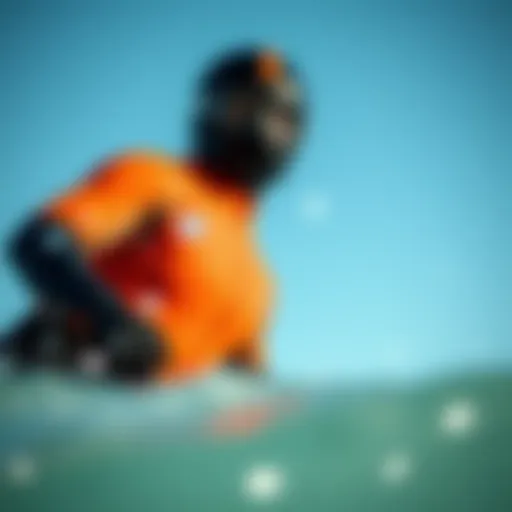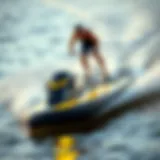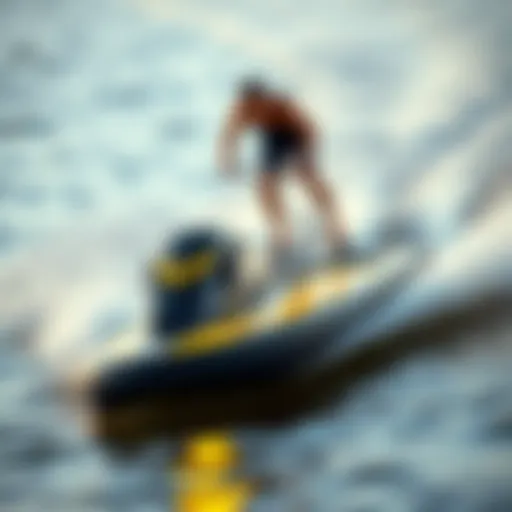A Comprehensive Guide to Beginner Kiteboarding
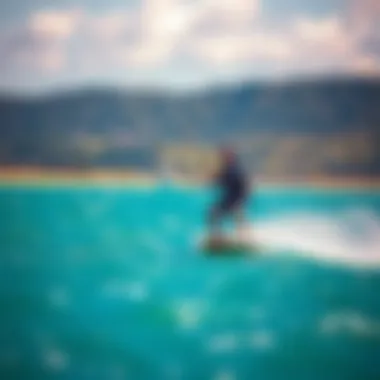

Intro
Kiteboarding, often described as a blend of surfing, windsurfing, and paragliding, has captured the hearts of adventure seekers across the globe. For anyone stepping into this exhilarating world, the initial stages can feel as daunting as trying to tackle a wild ocean wave. Don’t let that scare you off; it’s completely normal to feel a bit overwhelmed. The purpose of this guide is to break down every aspect of kiteboarding while shining a light on the key aspects that can ease your learning path.
In this guide, you’ll find not just a breakdown of the equipment needed, but also insights into the intricate dance between the wind and the kite. Safety doesn't take a back seat either—understanding how to protect yourself is crucial for enjoying this sport to its fullest potential. Finally, as you gain your footing, you’ll learn about the thriving kiteboarding community waiting to welcome you into its fold.
The beauty of kiteboarding lies not just in the adrenaline of soaring through the sky, but also in the camaraderie among kiteboarders. The activity presents opportunities to connect with seasoned veterans and newbies alike. So, if you’re ready to discover where the wind takes you, let’s dive in!
Gear Insights
Staying well-informed about the best equipment is the first step on your journey. Kiteboarding gear doesn’t just come in one size fits all; it’s vital to choose equipment that fits your skill level, weight, and the conditions in which you’ll be riding. You wouldn't want to hit the waves without proper gear, now would you?
Latest Gear Reviews
In assessing the market, a few standout gear options have recently captured attention:
- North Kiteboarding Impact Kite*: Renowned for its durability and user-friendly design, this kite is excellent for beginners learning the ropes.
- Duotone Evo: A versatile kite that adapts well to various winds, setting you up for success in changing conditions.
- Liquid Force Rocket Board**: Lightweight and buoyant, this board makes it easy to glide across water, providing a stable platform for new riders.
These pieces combine quality with accessibility, ensuring new kiteboarders can enjoy their experience without struggling with inadequate gear.
Essential Gear for Beginners
At the bare minimum, every beginner kiteboarder should own:
- Kite: Choose a beginner model that suits your weight and local wind conditions.
- Control Bar: This is your lifeline, allowing you to direct the kite while maintaining critical safety features.
- Harness: Choose between seat or waist harnesses based on comfort.
- Board: A beginner kiteboard should be wide and stable, allowing for easy balance as you start.
- Safety Leash: This should be attached to your harness, serving as a fail-safe in case of unexpected situations.
The right gear is the linchpin of a good kiteboarding experience, enhancing both safety and fun.
"Safety is not just a piece of advice; it's the foundation upon which your enjoyment is built."
As you gather your equipment, remember, funding quality gear is an investment in your safety and enjoyment.
Techniques and Tips
Once the right gear is in your hand, it’s time to learn the ropes—literally! Mastering kiteboarding techniques will take practice, patience, and a willingness to learn from mistakes.
Basic Techniques for Novices
- Kite Control: Getting familiar with your kite's responsiveness is essential. Spend time flying it on land in varying wind conditions.
- Launch and Land: Developing a solid routine for launching and landing your kite is crucial for safety and ensuring successful sessions.
- Body Dragging: This technique helps you get comfortable in the water, allowing the kite to pull your body without the board initially.
Safety Practices for Kiteboarders
- Understand Wind Conditions: before hitting the water, check forecasts and understand the wind direction relative to the launch site.
- Wear Protective Gear: A helmet, impact vest, and possibly shin guards can save you from unpleasant injuries.
- Stay Aware of Your Surroundings: Always gauge your distance from others and watch for boats or obstacles.
The above practices will serve as the backbone of your kiteboarding journey, keeping both skills and safety at the forefront.
As you take your first steps into this fascinating sport, remember that each kiteboarder was once where you are now. With the right gear and knowledge, you’ll soon find yourself not just riding the waves, but dancing with the wind.
Foreword to Kiteboarding
Kiteboarding, a sport that dances between the wind and water, has become a captivating hobby for many around the globe. It’s not merely about gliding on the waves; it’s about understanding the rhythm of the wind and mastering the art of harnessing it to your advantage. This introduction is crucial, setting the stage to illuminate the essential components of kiteboarding that every beginner should grasp.
As a novice, stepping into kiteboarding can seem daunting. Questions abound: What’s involved in the gear? What techniques should one learn first? This guide aims to delve deeper into those queries. Recognizing the importance of a solid foundation in kiteboarding lays the groundwork for a thrilling adventure on the water.
One significant benefit of learning about kiteboarding is the connection to nature it fosters. You get to feel the elements—wind pulling you upward and water guiding your movement, creating a unique bond between rider and environment. Moreover, kiteboarding builds both physical and mental skills, promoting fitness, balance, and resilience. It’s also a social sport; from local meetups to global competitions, kiteboarding opens doors to communities that share your passion.
Finally, before entering the arena, understanding the risks and safety practices is imperative. Kiteboarding has its particularities that differ greatly from other water sports, and being informed helps you navigate these waters smartly. With this introduction, we now transition into a fundamental question that sparks curiosity:
What is Kiteboarding?
Kiteboarding, or kitesurfing as some call it, is a wind-powered water sport where a rider is pulled across the water by a kite. The kite, controlled by a harness and control lines, catches the wind, propelling the rider on a surfboard or a wakeboard. It’s a thrilling experience that combines elements of surfing, windsurfing, and paragliding, allowing participants to perform tricks, jumps, and crosses on waves and flat water alike.
The Evolution of Kiteboarding
The roots of kiteboarding can be traced back to the late 1960s and early 1970s when surfers began experimenting with kites. However, it wasn't until the 1990s that the sport took form as we know it today. With innovations in kite design and safety features, kiteboarders began to ride with more freedom and style.
The development of leashes, safety systems, and user-friendly kites led to a surge in popularity during the early 2000s.
Today, kiteboarding is a global phenomenon with professional competitions drawing large crowds and a wide array of enthusiasts. The evolution of the sport reflects technological advancements and shifts in culture, making kiteboarding not just a hobby but a lifestyle for many adventurers.
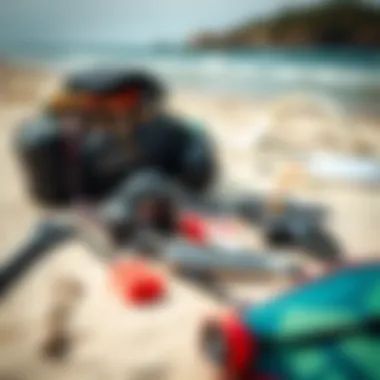
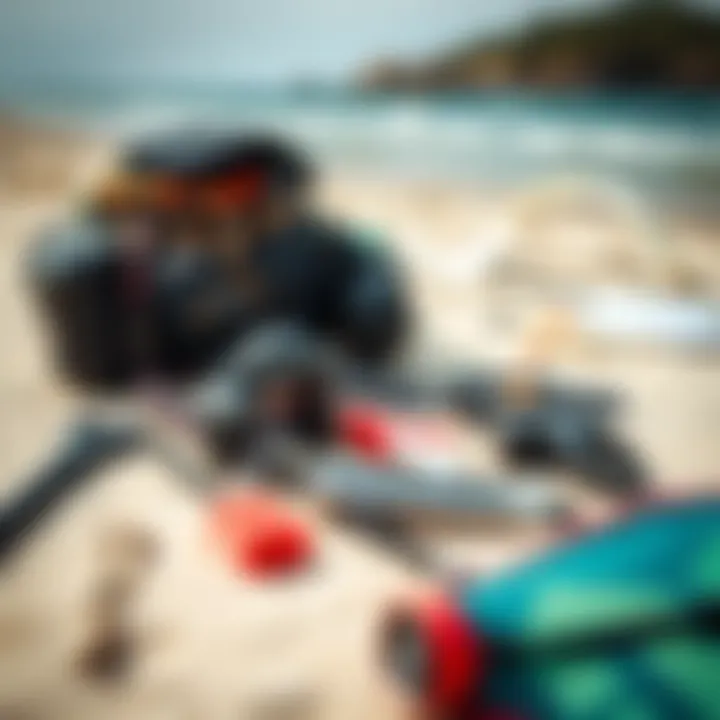
Essential Gear for Beginners
Selecting the right gear is a fundamental aspect of kiteboarding, particularly for those who are just starting out. The equipment you choose can greatly impact your ability to learn and enjoy the sport, making the selection of your initial kit a crucial decision. Quality gear can enhance your safety, improve your learning curve, and ultimately add to your overall experience on the water. In this section, we will explore the key components you will need to begin your kiteboarding journey, including kite types, boards, harnesses, and essential safety equipment.
Understanding Kite Types
When it comes to kiteboarding, the type of kite you use plays a pivotal role in your performance and enjoyment. Kites can vary significantly in shape, size, and design, impacting how they handle in different wind conditions. The two main types of kites are LEI (Leading Edge Inflatable) and Foil kites.
- LEI Kites: These kites are characterized by their inflatable leading edges, making them stable and easy to control. They’re great for beginners since they are generally more forgiving in terms of performance and safety. The ability to relaunch them from the water is an added bonus, as this can save you from extended swims back to shore.
- Foil Kites: Unlike LEI kites, foil kites are made without inflatable frames. They rely on their shape to capture wind and generate lift. While they can offer a lighter design and a smoother flying experience, they often require a bit more skill to handle, making them less ideal for newcomers.
Additionally, kites come in different sizes which correspond to various wind conditions. It’s crucial to select a kite size that matches typical winds in your chosen location. Smaller kites are better for high winds, while larger kites excel in lighter wind conditions. Newbies are often advised to consult local experts to pin down the best size for local environments.
Choosing the Right Board
The board is what gives you the foundation to ride on the water, so selecting the right one cannot be overstated. Kiteboarding boards typically fall into two main categories: Twin-Tip Boards and Directional Boards.
- Twin-Tip Boards: These boards can be ridden in either direction, making them perfect for beginners who are still figuring things out. The symmetrical design allows for easy transitions and can help new riders feel more comfortable.
- Directional Boards: For riders who want to surf on waves, directional boards are the way to go. However, they require a slightly more advanced skill set and are less forgiving for those who are still learning the basics.
When choosing a board, consider your weight, skill level, and the typical water conditions you expect to encounter. A board that fits your size will greatly affect your ride. A wider board can provide more stability, while a narrower board might be better for jumping and tricks once you advance in skill.
Harness Selection
Harnesses are often overlooked but are essential because they connect you to the kite and take the load off your arms, allowing for better control and more comfortable riding. There are two main types of harnesses: Waist Harnesses and Seat Harnesses.
- Waist Harness: This type is favored by many kiteboarders for its freedom of movement and ability to provide better back support. It’s generally more comfortable for tricks and jumps, which could come in handy as you progress.
- Seat Harness: This option is usually preferred by novices, as it provides more support and stability. If you find yourself struggling to stay in control, a seat harness can help keep you grounded.
Ultimately, comfort should be a priority when choosing a harness. A proper fit will ensure you can fully enjoy your time on the water without feeling restricted.
Safety Equipment Necessities
Finally, safety gear is not optional; it's a must. While kiteboarding is an exhilarating sport, it also comes with its risks. Here are essential items that every beginner should consider:
- Kite Leash: This is used to keep your kite attached to you, providing safety should you lose control.
- Life Jacket: It’s a good practice to wear a life vest or buoyancy aid, particularly if you are learning in deeper waters.
- Helmets: A helmet can protect you from head injuries, especially during falls or mishaps.
> Always prioritize safety first. The excitement of kiteboarding can make you forget about potential risks; never underestimate the importance of being prepared.
With the right gear, you'll set yourself up for success as you embark on this exciting adventure. Select carefully and make sure each piece of equipment fits your needs and comforts. You aren’t just investing in gear; you are investing in your kiteboarding experience.
Basic Techniques for Kiteboarding
Basic kiteboarding techniques serve as the backbone of a novice's journey into this thrilling sport. Understanding these foundational skills is critical in ensuring safety, confidence, and enjoyment while riding the waves. Getting these techniques right lays the groundwork for more advanced maneuvers in the future. With kiteboarding relying on the harmonious relationship between the kite, the rider, and the wind, proper technique can markedly enhance your experience and competence on the water.
Getting Prepared: Launching the Kite
Launching the kite is perhaps one of the most crucial aspects of kiteboarding. A successful launch ensures that you start your session with the right attitude; you don’t want to be scrambling on the shore while the wind threatens to pick your gear up and toss it into the water.
When launching, it helps to have a buddy with you. First, lay the kite down on the beach, ensuring the lines are straightened out without tangling. Position yourself just a few steps back while keeping the kite's leading edge facing into the wind. As you get ready, engage your buddy to hold the wingtip of the kite. The kite will be ‘on the edge of the wind window,’ which is essential for a smooth ascent.
- Steps to Launch the Kite:
- Inspect your lines for tangles or knots.
- Lay the kite on its back, face into the wind.
- Firmly hold one wingtip, waiting for your signal to clients or your buddy.
- Call out "kite up" when ready.
- As the kite begins to rise, maintain tension.
Launching a kite might seem simple, but getting it wrong can lead to mishaps. With practice, you’ll soon find that this process becomes second nature.
Controlling the Kite
Once the kite is launched, learning how to control it is the next big step. Control allows for steering and maintaining the kite's position in relation to you and the wind, which is vital for kiteboarding.
Using the control bar, you can steer the kite and manipulate its angle. Pulling the bar down towards you, known as edging, will give the kite more power and speed. On the flip side, pushing the bar away softens the pull, allowing for a more relaxed ride. Think of your body as a GPS for the kite; where you orient your body often dictates the kite's direction.
- Key Points for Controlling Your Kite:
- Understand the wind window and how it influences kite movement.
- Practice gentle pulls and pushes on the control bar to feel the kite’s response.
- Use smooth motions to maintain control without jerking the kite.
Mastering kite control is not only about steering but also about handling varying wind conditions. A fidgety kite can make for a tumultuous ride, while a well-controlled kite can smooth out your journey on the waves.
Water Start Techniques
The transition from stable ground to the more unstable watery environment is oftentimes intimidating for beginners. The water start technique serves as a bridge to this transition, allowing you to get up on the board smoothly after the kite has powered you.
Start by positioning the board in front of you while holding onto the control bar with your other hand on the back of the kite. As the kite pulls you, use that momentum to flip your feet into the board, pushing your weight down onto it. When done correctly, you’ll be standing up on the board before you know it.


"The first time you stand up on the board, it's a rush!"
Here are some points to remember while learning the water start:
- Make sure you are ready and the kite is at the right angle in the wind window.
- Use your hips to pull yourself up rather than your arms.
- Maintain a low center of gravity before standing.
Riding Basics: Balancing on the Board
Achieving balance on the board is where the magic happens in kiteboarding. After the water start, maintaining that balance is key to maneuvering effectively on the water. An imbalanced rider ends up face-first in the water instead of carving through waves.
Start by positioning your feet firmly on the board. Keep your knees slightly bent and align your body towards your preferred direction. Leaning too far back can cause you to lose speed, while leaning too far forward will lead to a nosedive. It's a delicate dance of weight and motion.
- Tips for Maintaining Balance:
- Relax your body. Tension often leads to stiffness and loss of balance.
- Use your arms for additional balance and counterweight.
- Get comfortable with shifting your weight to adjust your speed and direction.
With practice, riding will feel more instinctive. Swinging around turns, catching air, or smoothly gliding over the waves will soon be your norm as a kiteboarder. Understanding balance not just enhances safety but elevates your overall riding experience.
Safety Practices in Kiteboarding
Kiteboarding is undeniably an exhilarating sport, but it doesn’t come without its risks. Ensuring safety practices are observed is critical for every kiteboarder, especially those just starting on this thrilling journey. Understanding the fine line between a fantastic day on the water and a potentially dangerous situation can make all the difference. Safety practices equip beginners with the necessary awareness, helping to mitigate risks associated with kiteboarding.
Understanding Wind Conditions
One of the cornerstones of safe kiteboarding is grasping wind conditions. Wind can be a kiteboarder's best friend or worst enemy. The intensity and direction of the wind dramatically affect both kite performance and rider control. Beginners must learn to interpret wind flags, as they signal safe conditions to ride.
Kiteboarding in varying wind conditions includes:
- Light Wind: Ideal for beginners, typically under 12 knots, allowing more time to control the kite.
- Moderate Wind: Ranges from 12 to 20 knots, suitable for those getting comfortable on the board.
- Strong Wind: Over 20 knots can be challenging and risky for novices. These conditions require a skilled understanding of your gear and the environment.
To ensure safety, never head out unless you've checked the wind forecast. Local weather stations or apps, like Windy.com or KiteForecast, can be incredibly useful in this endeavor.
Identifying Hazards
Hazard awareness is another critical aspect of kiteboarding safety. Every location has its unique challenges that a beginner should consider. Whether it's rocks, shallow waters, or other water users like swimmers and boaters, being aware of these hazards can help avoid collisions and dangerous situations.
Common hazards that should be kept in mind include:
- Obstacles in the Water: Look out for reefs, rocks, or any floating debris that could cause injury or damage.
- Wind Shadow Areas: Places where wind is obstructed can cause sudden drops in power, jeopardizing control of the kite.
- Crowded Environments: Kiteboarding spots can become busy, especially on sunny weekends. Be vigilant about other kiters or watercraft.
Awareness is your first line of defense. Sometimes, unforeseeable situations arise despite careful planning, so having a plan for unexpected hazards is paramount.
Emergency Protocols
A sound safety plan is your best friend during emergencies. Every kiteboarder should know basic emergency protocols to handle unfortunate incidents effectively. You don’t want a thrilling day to turn into chaos simply because you’re caught off guard.
Emergency procedures include:
- Self-Rescue Techniques: Knowledge of how to fully depower the kite and use it as a flotation device can be lifesaving.
- Communication: Carry a whistle or an air horn; these can serve as signals to fellow kiters and help in drawing attention during emergencies.
- Buddy System: Kiteboarding with a partner can provide an extra layer of safety. Keeping an eye on each other helps ensure that you're both aware of each other’s conditions and surroundings.
"In the heat of the moment, knowing what to do can make a significant difference. Preparation is key to making sure fun doesn't turn into panic."
Familiarizing yourself with these safety practices prepares you for a secure kiteboarding experience. As you embrace this thrilling sport, prioritizing safety ensures that your kiteboarding journey is not only exciting but also enduring.
Finding the Right Learning Environment
Selecting the right learning environment for kiteboarding can significantly shape a novice's experience. Unlike many sports that can be practiced virtually anywhere, kiteboarding demands specific conditions and locations. The interplay of wind, water, and space all contribute to effective learning.
Benefits of an Ideal Learning Environment
Kiteboarding is best learned in places where the wind is steady and predictable. Locations like flat waters and sandy shores make it easier to master controlled movements without the added risks of waves or currents that can distract and deter learners. Think of it this way: trying to learn a new skill in a chaotic setting is like trying to dance at a rock concert. You may be moving, but it’s tough to find your rhythm.
When a beginner has a conducive environment, they’re more likely to build confidence faster. Schools and instructors can focus on teaching skills instead of constantly addressing issues related to the environment, making lessons smoother and, generally, more enjoyable. Therefore, knowing where to practice is half the battle won.
Selecting Locations for Beginners
Picking a spot to learn kiteboarding isn’t just about thrill; it’s about safety and accessibility. Here are a few key considerations:
- Wind Patterns: Sites with consistent winds mean fewer surprises. Beginners shouldn’t have to battle with fluctuating gusts.
- Water Conditions: Flat water locations, such as lagoons or large bays, allow newcomers to get their balance without the challenge of waves. The absence of obstacles like rocks or strong currents is crucial for safety.
- Space to Maneuver: Rooms for practicing basic skills is a must. Areas that are too crowded can lead to mishaps and injuries, which can be discouraging.
Some popular beginner-friendly kiteboarding destinations include
- La Ventana, Mexico: Known for its perfect wind conditions, it's a haven for learners looking to get their feet wet.
- Cape Hatteras, North Carolina: With its steady winds and shallow waters, many schools choose this as a top training ground.
- Cumbuco, Brazil: Apart from its stunning beaches, the location boasts consistent winds, making it ideal for novices.


Kiteboarding Schools and Instructors
Finding qualified instructors and reputable schools can make or break your learning experience. Experts suggest seeking out schools that have a structured curriculum and certified instructors. Here’s what to look for:
- Certifications: Ensure the instructors are certified by reputable organizations, such as the International Kiteboarding Organization (IKO). It shows that they meet industry standards.
- Teaching Style: Different instructors have varying methods. Some may emphasize safety and theory before practice, while others prefer a hands-on approach. It’s worth sitting in on a couple of lessons before committing.
- Small Class Sizes: More individualized attention generally leads to faster progression. Schools with small student-to-instructor ratios often yield better results.
- Reviews and Testimonials: Peer feedback can be invaluable. Check reviews on platforms like Reddit or local Facebook groups to gauge others' experiences.
"A good instructor can steer you from mishaps and help establish the groundwork for your skills. It’s not merely about boarding; it’s about understanding the wind and the ocean."
In summary, equipping yourself with the right information about your learning environment can set you up for kiteboarding success. Opt for locations that cater to beginners, and invest time in finding an instructor who resonates with your learning style. This groundwork will not only ensure safety but also enhance your enjoyment and progression in the sport.
Community and Resources for Kiteboarders
The journey into kiteboarding is not just about mastering the waves or catching the perfect gust of wind; it's also deeply rooted in the community that surrounds it. Finding your tribe can make the difference between feeling lost on the water and experiencing a true sense of belonging. Within this vibrant community, you'll discover a wealth of information, shared experiences, and lifelong friendships. Simply put, engaging with fellow kiteboarders enriches the entire experience, offering the support and motivation needed to propel your skills to the next level.
Online Forums and Groups
Online platforms serve as touchpoints for kiteboarders, learners, and enthusiasts alike. Sites like Reddit have dedicated sections where you can engage with others who share your passion. These discussions can range from equipment recommendations to technique tips and safety precautions. Why is this beneficial? Here are a few reasons:
- Information Sharing: Online forums allow for a wider exchange of knowledge. You can ask questions, share your experiences, and learn from others who may have faced similar challenges.
- Real-time Advice: If you're contemplating purchasing specific gear or traveling to a new location, turn to these platforms for immediate feedback.
- Networking Opportunities: Connecting with fellow kiteboarders can lead to partnerships, group outings, or even training with experienced instructors.
Don't overlook social media, especially platforms like Facebook. Groups dedicated to kiteboarding are aplenty and provide a ready-made community that you can tap into. Whether it's through sharing photos of your latest achievements or seeking advice on wind conditions, these groups keep you updated on trends and local happenings in the kiteboarding world.
Local Meetups and Events
When it's time to get off the screen and onto the water, local meetups and events come into play. These gatherings often consist of kiteboarding clinics, competitions, or simply get-togethers at popular kiteboarding spots. It’s a great way to engage with your peers in real life and push your skills further. Some considerations about local meetups include:
- Skill Development: Attending organized events can rapidly refine your skills. Clinics often involve coaching from seasoned kiteboarders who provide tailored insights.
- Fun Factor: Kiteboarding is a social sport. Gathering with others to ride the waves and learn new tricks lightens the grind and keeps motivation high.
- Community Engagement: Many local events are supported by kiteboarding shops or schools, fostering a cycle of support within the community. You may find a local instructor who can provide additional resources and help you progress.
Advancing Beyond Beginner Skills
As one embarks on the kiteboarding journey, the initial thrill of simply staying atop the board is often exhilarating enough. Yet, it's important to remember that kiteboarding is more than just getting started. Advancing beyond beginner skills opens the door to a world of possibilities that redefine the kiteboarding experience. This section emphasizes not only the significance of continuing to develop your skills but also the engagement with the broader kiteboarding community.
The first step beyond the basics can often feel daunting; many beginners might feel a tinge of anxiety when thinking about moving to the next phase. However, elevating your kiteboarding skills provides multiple benefits like increased safety, enhanced enjoyment, and the opportunity to meet like-minded enthusiasts. When skills progress, so does the confidence, allowing for bolder maneuvers and a deeper connection with the elements.
Intermediate Techniques
Intermediate techniques often serve as a keystone for that leap from a fledgling rider to a competent one. Skills such as edging, transitioning, and jumping become crucial as they form the bedrock for more advanced tricks. Learning to edge effectively means harnessing the power of the kite and navigating through wind conditions with precision. You might remember the feeling of just gliding over the water; edged riding allows you to harness that feeling while gaining speed and controlling direction more efficiently.
- Edging: This is essential for controlling speed and maintaining balance when you’re carving through the water. Initially, practice on flat water to get a feel for it. You'll find yourself adjusting your hips and weight distribution to shift in and out of the water.
- Transitioning: Transitioning from one direction to another is vital in kiteboarding. It’s not just about turning; it’s about learning how to reposition and manage momentum effectively. Hooking into a transition while managing kite placement can set the stage for smoother rides.
- Jumping: It might be every beginner's dream, yet it requires a solid foundation. Start small by compressing and then extending your legs to gain lift. Maintaining kite control while in the air is fundamental; the kite must be positioned appropriately to manage descent safely.
Completing these intermediate techniques introduces newfound freedom and excitement in the sport. It’s where kiteboarding transforms from a mere ride into an art form, allowing one to express individuality on the water.
Progressing to Tricks
The transition from basic riding to performing tricks can feel like entering a new dimension in kiteboarding. As you gain confidence, the allure of creativity and athleticism will undoubtedly beckon you. Tricks like the back roll, the kite loop, and sliding turns can be daunting at first, but they take your riding to exhilarating heights.
Trick progression requires consistent practice and a willingness to embrace failure. Here’s a quick look at three foundational tricks and their significance in advancing your skill set:
- Back Roll: This trick involves rotating backwards while airborne. Start with small jumps, ensuring your kite is not too high. As you jump, pull with your back hand; this will initiate the roll. Remember, smooth landings are crucial.
- Kite Loop: This trick combines speed and gravity. Looping the kite while airborne adds adrenaline and flair to your ride. Timing is essential; it often means learning to anticipate the kite’s movements and controlling your body's position in response.
- Sliding Turns: With sliding turns, you can showcase both style and control. This involves making sharp turns while leaning back into it. It's more than just a move; it requires confidence and a refined sense of edging.
"The more you push your limits, the bigger the reward. Even if you fall flat, remember that every trick learned brings you one step closer to mastering the art of kiteboarding."
As you push toward these skills, you'll realize that kiteboarding isn't just a sport; it's a journey that ties together discipline, passion, and community. The more you engage, the more you gain, both on the water and within the kiteboarding family. With resources like local clubs, social media groups, and instructional videos available on platforms like reddit.com, there’s no shortage of help to guide your growth.
Ultimately, advancing beyond beginner skills is more than just about tricks — it's about becoming part of something larger. Mastery comes with time and practice, and those extra hours on the water will serve as your ticket to the remarkable experiences that kiteboarding can provide.
Epilogue and Next Steps
Wrapping up your journey through the world of kiteboarding isn't merely about saying goodbye. Instead, it's about laying the groundwork for what comes next. This segment is super important, as it pulls together all the threads of knowledge you've gathered. You’ve explored gear, techniques, safety measures, and community resources; now let’s talk about how to keep that momentum going.
The key here is to recognize that kiteboarding, like many sports, is a continuous learning experience. There's a vast ocean of skills and nuances that awaits you. This means staying engaged with the sport, whether that’s through honing your current skills or exploring new techniques. Also, meeting fellow kiteboarders can turn this adventure from a solo endeavor into a vibrant community experience.
In a nutshell, the conclusion serves as both a recap and a launchpad for your next steps. It urges you to reflect on your kiteboarding journey thus far while inspiring you to take your skills to the next level.
Recap of Key Points
- Understanding Gear: You’ve learned the types of kites and boards and how they influence your ride. Don’t forget to maintain your equipment, as proper care goes a long way.
- Essential Techniques: Mastering the basic techniques is crucial. Remember, practice makes perfect. Consider revisiting the basics periodically, even as you advance.
- Safety Practices: Always prioritize safety. Familiarize yourself with wind conditions and have a plan for emergencies. This knowledge can be a lifesaver.
- Finding Learning Environments: There’s wisdom in finding the right spots and instructors. Ask around locally or do some research online for the best learn-to-kite locations.
- Building a Community: Engaging with local groups or online forums keeps you in the loop and motivated. The kiteboarding community is welcoming and thrives on shared experiences.
"The only way to learn is to live. To experience not just the wind at your back, but the mistakes along the way."
Encouraging Continued Learning
There's no end to the learning curve in kiteboarding. Staying curious and proactive opens up a world of challenges and adventures. Consider these pathways:
- Join Workshops and Clinics: Participating in specialized training sessions can sharpen your skills, especially when dealing with advanced tricks or conditions.
- Set Personal Goals: Whether it’s mastering a new trick or increasing your distance, setting goals can provide motivation and direction.
- Follow Experts Online: Blogs, YouTube channels, and social media are treasure troves of tips and insights. People often share their experiences and techniques, so dive in!
- Experiment with Gear: As you grow, you might want to try different kites or boards to see how they affect your riding style. Testing new equipment can enhance your skills dramatically.
- Attend Events: Kiteboarding competitions, meetups, or local gatherings can connect you with fellow enthusiasts and broaden your understanding of the sport.
In closing, kiteboarding is more than just a hobby; it's a way to stretch your limits, embrace nature, and join a community that shares a passion for adventure. By keeping these points in mind as you move forward, you'll not only enjoy your kiteboarding journey more but also grow as a kiteboarder.



